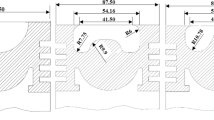Abstract
This paper presents a study on the effect of re-entrant piston bowl configuration on the emissions characteristics and engine performances of a direct injection (DI) diesel engine. In order to meet the emission norms, modern-day diesel engines rely on methods of in-cylinder emission reduction and expensive after treatment device. By using an effective piston bowl shape, one can reduce the in-cylinder emission and the cost increased for the after-treatment device with considerable increase in the engine lifetime. Six piston bowl shapes with various geometric configurations were selected for numerical simulations. Three-dimensional models of the piston bowl shapes and the combustion chamber were created using Pro-E and mesh was generated by using preprocessor ANSYS ICEM CFD. The flow characteristics inside the cylinder with these piston bowls were investigated under steady condition with the RNG k-ε turbulent model using ANSYS Fluent. Numerical simulations under isothermal condition were carried out to select an optimum bowl shape. The mass flow boundary condition was used for inlet manifold and the value of this was measured from the experimental test. The CFD results of mean swirl velocity of the engine at different locations inside the combustion chamber were calculated. From the computational results, it was found that the average swirl number is increased from 0.87 (base shape) to 1.74 (modified bowl shape). It is well known that the swirl number is very important to enhance the homogeneity of air/fuel mixture inside the combustion chamber, which in turn improves the combustion efficiency. The experimental results shows that, as compared to the baseline engine 20 % reduced in hydrocarbons (HC) emissions and 24 % reduced in carbon monoxide (CO) for the engine with modified piston bowl shape. However, there is a small amount of reduction in engine performance. It is observed that the brake specific fuel consumption (BSFC) reduced significantly for all load conditions.
Similar content being viewed by others
References
V. Ganesan, “Internal Combustion Engines” Tata McGraw-Hill publishing, 2012.
Lu Lin, DuanShulin, Xiao Jin, Wu Jinxiang and GaoXiaohong “Effects of Combustion Chamber Geometry on In-Cylinder Air Motion and Performance in DI Diesel Engine” Paper no: 2000-01-0510, SAE, 2000.
Heywood J.B. “Internal Combustion Engine Fundamental” McGraw-Hill International Editions, New York, 1988.
Rahman M. Montajir, H. Tsunemoto and H. Ishitani “Fuel Spray Behaviour in a Small DI Diesel Engine: Effect of Combustion Chamber Geometry” Paper no: 2000-01-0946, SAE, 2000.
B.V.V.S.U. Prasad, C.S. Sharma, T.N.C. Anand, R.V. Ravikrishna “High swirl-inducing piston bowls in small diesel engines for emission reduction” Paper no:88 (2011) 2355–2367, Applied Energy, 2011.
Y. Zhu, H. Zhao, D. A. Melas and N. Ladommatos “Computational Study of the Effects of the Re-entrant Lip Shape and Toroidal Radii of Piston Bowl on a HSDI Diesel Engine’s Performance and Emissions” Paper no: 2004-01-0118, SAE, 2004.
Caroline L. Genzale and Rolf D. Reitz “A Computational investigation into the effects of Spary Targeting, Bowl Geometry and Swirl Ratio for Low-Temperature combustion in Heavy-Duty Diesel Engine” Paper No: 2007-01-0119, SAE, 2007.
Shabbir Sheikh, Nitin Gokhale and Vishal Thatte “Efficient Approach for Optimization of Piston Bowl Shape, Compression Ratio and EGR for DI Diesel Engine” Paper No: 2011-24-0013, SAE, 2011.
Arturo de Risi, Teresa Donateo and Domenico Laforgia “Optimization of the Combustion Chamber of Direct Injection Diesel Engines” Paper No: 2003-01-1064, SAE, 2003.
Jaeman Lim and Kyoungdoug Min “The Effects of Spray Angle and Piston Bowl Shape on Diesel Engine Soot Emissions Using 3-D CFD Simulation” Paper no: 2005-01-2117, SAE, 2005.
Acknowledgments
This research work was carried out in the Vel Tech-Dassault Systems Centre for the Design, Engineering and manufacturing located at the Research Park, for experimental work was carried out in the Automotive Engine Test facility lab, Vel Tech Technical University, Chennai.
Author information
Authors and Affiliations
Corresponding author
Editor information
Editors and Affiliations
Rights and permissions
Copyright information
© 2017 Springer Science+Business Media Singapore
About this paper
Cite this paper
Sakthisaravanasenthil, K., Senthilkumar, S., Sivakumar, G. (2017). A Study on Effect of Piston Bowl Shape on Engine Performance and Emission Characteristics of a Diesel Engine. In: Bajpai, R.P., Chandrasekhar, U. (eds) Innovative Design and Development Practices in Aerospace and Automotive Engineering. Lecture Notes in Mechanical Engineering. Springer, Singapore. https://doi.org/10.1007/978-981-10-1771-1_61
Download citation
DOI: https://doi.org/10.1007/978-981-10-1771-1_61
Published:
Publisher Name: Springer, Singapore
Print ISBN: 978-981-10-1770-4
Online ISBN: 978-981-10-1771-1
eBook Packages: EngineeringEngineering (R0)




